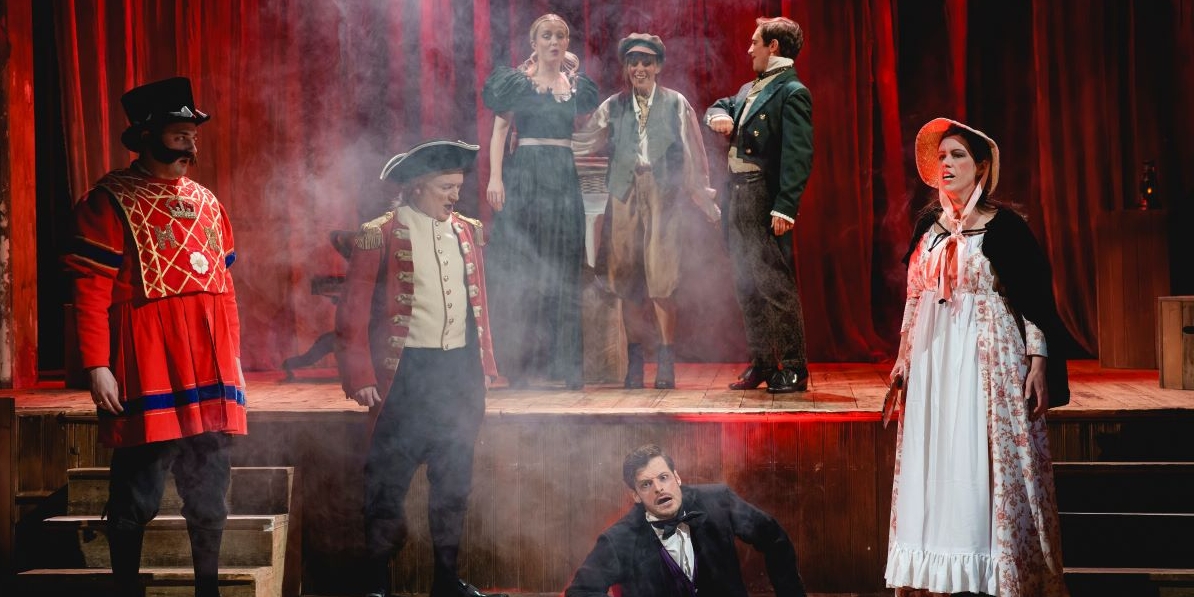Any call ‘to attend the tale of Sweeney Todd’ summons up Broadway rather than Hoxton; but it was at the Britannia Theatre, Hoxton in 1847 that this gruesome tale first came to light in the form of a Victorian melodrama penned by George Dibdin Pitt. Melodrama is a dramatic genre almost lost to us: such tales of tension and suspense, blackguardly villains and bashful victims, seem like so much hokey fustian. But the reality was a lot more substantial than the legends of hammy excess passed down in Hollywood caricature; in fact it is a tradition best seen as the contemporary English equivalent of the heroic actors celebrated in France in that peerless film ‘Les Enfants du Paradis.’
Moreover, thanks to the original research of musicologists such as the late Michael Pisani, we now know so much more about the music and performance conventions of such works. In particular, the presence of an orchestra which provides not only accompaniments to songs but also a continuous intricate commentary under the spoken text that opens up whole new vistas of research into the nineteenth-century origins of film music. But this is not merely or mainly a labour of historical recovery. It has to work in the theatre too in front of today’s audience with very different preconceptions. It is hugely to the credit of the enterprising revivalist determination of director Jeff Clarke and Opera della Luna that this work comes to us now in a form that respects and recreates the spirit of the original while offering easy accessibility and cheeky panto-style fun.
Wiltons, itself dating from the same era, is of course an ideal venue, with its split-level stage offering practical advantages too, not least in the disposal of bodies. A cast of seven take on a multiplicity of roles, a source of many (literal) running gags in a sprightly text tastefully updated by the director. There is a pacy comic zest in the air which only occasionally tips over into archness, high-camp and farce. Audience boos, hisses and cheers are encouraged and the highly skilful eleven-piece orchestra provide stage noises over and above the demands of the score. While the original music is lost, melodrama scores of the period by Balfe, Benedict and Bishop are rearranged plausibly. The first half fizzes past, and while the second is a tad diffuse, the whole is a revelation, offering a very different take on the story from Sondheim. Stock characters replace self-reflection and detailed motivation; and comic sub-plots and the stolen string of pearls turn out to be more important than Mrs Lovett and her pies.
Todd himself, depicted with imperious disdain by Nick Dwyer, is motivated purely by greed and gothic delights. Up against him is the plucky apprentice lad, Tobias, played by Caroline Kennedy with cheerful, faux naive energy, alongside a range of dubious authority figures who already seem close to the satirical world of Gilbert and Sullivan, especially Ben-the-Beefeater, one of several jolly characters embodied by Matthew Siveter. Much of the cast is wrapped up in the sub-plot of the Oakley family, centred around Johanna, intended recipient of the pearl necklace. The vocal demands on this role are quite substantial and they are met with panache by Madeline Robinson. Besides her quarreling parents, the key figure is the maid Cecily, a wily soubrette role delivered with bravura comic invention by Lynsey Docherty, who also offers a memorable cameo appearance as Mrs Lovett, more ruthless businesswoman than deranged Angela Lansbury. Stealing the show is Paul Featherstone whose oily, ingratiating clergyman, Rev Lupin, a Tartuffe in Methodist clothing, almost eclipses Todd himself. Matt Kellet has the task of playing a range of mostly morally good and largely ineffectual men, including Todd’s main victim.
Designer Elroy Ashmore has created a trap door on the lower stage for Todd’s victims and a series of gauzy shabby curtains at the rear which are coloured garishly by Paul Knott’s mood-setting lighting. Windows are also projected artificially to signal a change of locale; and tea boxes and props provide economical furnishings for swift scene changes. A very appealing pile of pies suggests Melton Mowbray rather than an abbatoir. Period clothing predominates, and all credit to those off-stage assisting with the many rapid changes of costume. In what is a long evening the technical deftness of the actors and backstage team really matters.
This production is both an important moment in recovering theatre history and a truly fun night out. You can’t often get to say both of those things in a review, and on the rare occasions you can it is generally a sign of a five-star event.

